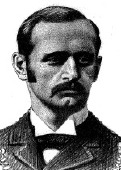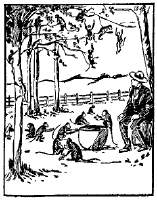
William Randolph Hearst, owner of the New York
Journal, had a reputation for never letting truth get in the way of a good story. According to one famous tale, when hostilities broke out between the Spanish and the Cubans, Hearst sent the illustrator Frederic Remington to Cuba to draw pictures of the conflict. Finding that not much was happening, Remington cabled Hearst in January 1897: "Everything is quiet. There is no trouble here. There will be no war. I wish to return."
Supposedly Hearst cabled back: "Please remain. You furnish the pictures and I'll furnish the war."
It is doubtful Hearst ever sent such a telegram. The first report of it appeared in a 1901 book,
On the Great Highway, by journalist James Creelman. Creelman was in Europe at the time the telegram was supposedly sent, so he either heard the story second-hand or invented it himself. Since he was known for exaggeration, the latter is likely. Hearst himself denied having sent such a telegram.
More…

 William Randolph Hearst, owner of the New York Journal, had a reputation for never letting truth get in the way of a good story. According to one famous tale, when hostilities broke out between the Spanish and the Cubans, Hearst sent the illustrator Frederic Remington to Cuba to draw pictures of the conflict. Finding that not much was happening, Remington cabled Hearst in January 1897: "Everything is quiet. There is no trouble here. There will be no war. I wish to return."
William Randolph Hearst, owner of the New York Journal, had a reputation for never letting truth get in the way of a good story. According to one famous tale, when hostilities broke out between the Spanish and the Cubans, Hearst sent the illustrator Frederic Remington to Cuba to draw pictures of the conflict. Finding that not much was happening, Remington cabled Hearst in January 1897: "Everything is quiet. There is no trouble here. There will be no war. I wish to return." Prescott Jernegan claimed he had found a way to cheaply extract gold from sea water. His "Gold Accumulator" consisted of a wooden box, inside of which was a pan of mercury mixed with a secret ingredient. A wire connected the mercury to a small battery. When lowered into the ocean, this contraption supposedly sucked gold out of the water.
Prescott Jernegan claimed he had found a way to cheaply extract gold from sea water. His "Gold Accumulator" consisted of a wooden box, inside of which was a pan of mercury mixed with a secret ingredient. A wire connected the mercury to a small battery. When lowered into the ocean, this contraption supposedly sucked gold out of the water. In February 1899, numerous American newspapers, including the Los Angeles Times, printed a story claiming that a farmer, W.W. Mangum, had successfully trained monkeys to pick cotton on his plantation in Smedes, Mississippi. The story was sourced to an article in the Cotton Planters' Journal by T.G. Lane. Reportedly Mangum was so pleased with the success of his monkey-labor experiment that he had ordered more monkeys from Africa, and he was urging other planters to join him in using simians as laborers. There is no evidence this story was true. In fact, the tale of monkeys being trained to pick cotton (or other crops) was one of the more persistent legends that circulated in the American South during the second half of the nineteenth century. Versions of it appeared in newspapers every few years.
More…
In February 1899, numerous American newspapers, including the Los Angeles Times, printed a story claiming that a farmer, W.W. Mangum, had successfully trained monkeys to pick cotton on his plantation in Smedes, Mississippi. The story was sourced to an article in the Cotton Planters' Journal by T.G. Lane. Reportedly Mangum was so pleased with the success of his monkey-labor experiment that he had ordered more monkeys from Africa, and he was urging other planters to join him in using simians as laborers. There is no evidence this story was true. In fact, the tale of monkeys being trained to pick cotton (or other crops) was one of the more persistent legends that circulated in the American South during the second half of the nineteenth century. Versions of it appeared in newspapers every few years.
More…
 Woolly mammoths became extinct thousands of years ago. But in October, 1899 a story appeared in McClure's Magazine titled "The Killing of the Mammoth" in which a narrator named H. Tukeman described how he had recently hunted down and killed a mammoth in the Alaskan wilderness.
More…
Woolly mammoths became extinct thousands of years ago. But in October, 1899 a story appeared in McClure's Magazine titled "The Killing of the Mammoth" in which a narrator named H. Tukeman described how he had recently hunted down and killed a mammoth in the Alaskan wilderness.
More…